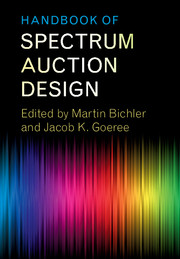Book contents
- Frontmatter
- Contents
- List of Contributors
- Preface
- List of Papers
- Part I The Simultaneous Multiple-Round Auction
- 1 Putting Auction Theory to Work: The Simultaneous Ascending Auction
- 2 An Equilibrium Analysis of the Simultaneous Ascending Auction
- 3 The Efficiency of the FCC Spectrum Auctions
- 4 Measuring the Efficiency of an FCC Spectrum Auction
- Part II The Combinatorial Clock Auction Designs
- Part III Alternative Auction Designs
- Part IV Experimental Comparisons of Auction Designs
- Part V The Bidders’ Perspective
- Part VI Secondary Markets and Exchanges
- Outlook
2 - An Equilibrium Analysis of the Simultaneous Ascending Auction
from Part I - The Simultaneous Multiple-Round Auction
Published online by Cambridge University Press: 26 October 2017
- Frontmatter
- Contents
- List of Contributors
- Preface
- List of Papers
- Part I The Simultaneous Multiple-Round Auction
- 1 Putting Auction Theory to Work: The Simultaneous Ascending Auction
- 2 An Equilibrium Analysis of the Simultaneous Ascending Auction
- 3 The Efficiency of the FCC Spectrum Auctions
- 4 Measuring the Efficiency of an FCC Spectrum Auction
- Part II The Combinatorial Clock Auction Designs
- Part III Alternative Auction Designs
- Part IV Experimental Comparisons of Auction Designs
- Part V The Bidders’ Perspective
- Part VI Secondary Markets and Exchanges
- Outlook
Summary
Introduction
In recent years, governments around the world have employed auctions to award licenses for the rights to operate in certain markets. The spectrum auctions conducted by the US Federal Communications Commission (FCC) provide a particularly prominent example. In the FCC auctions, telecom firms compete for blocks of frequencies (typically on the order of 10-20 MHz) defined over certain geographic areas. The format pioneered by the FCC is the simultaneous ascending auction (SAA), which is a dynamic, multi-round format in which the items are put up for sale simultaneously and the auction closes only when bidding on all items has stopped. The SAA has become the standard to conduct large-scale, large-stakes spectrum auctions and has generated close to $80 billion for the US Treasury and hundreds of billions worldwide.
An important property of the SAA is that when items are substitutes and bidding is “straightforward,” i.e. in each round of the auction bidders place minimum acceptable bids on those licenses that provide the highest current profits, then prices converge to competitive equilibrium prices and a fully efficient outcome results (Milgrom [18]; Gul and Stacchetti [14]). However, in many of the FCC auctions there are synergies between licenses for adjacent geographic regions, and bidders’ values for combinations of licenses exceed the sum of individual license values. For example, the bid regressions reported by Ausubel, Cramton, McAfee, and McMillan [2] show that the highest losing bid on a license is higher if the bidder who placed the bid has won or eventually wins a license. Bajari and Fox [5] apply a structural econometrics model to data from FCC auction #5 and find evidence for substantial value complementarities: they estimate that the value of a nationwide package is 69% more than the sum of underlying values. Value complementarities were considered even more important in the recently conducted FCC auction #73, where potential entrants, e.g. Google, competed against established incumbents such as Verizon and AT&T for highly valuable 700MHz spectrum.
- Type
- Chapter
- Information
- Handbook of Spectrum Auction Design , pp. 26 - 53Publisher: Cambridge University PressPrint publication year: 2017
- 1
- Cited by



